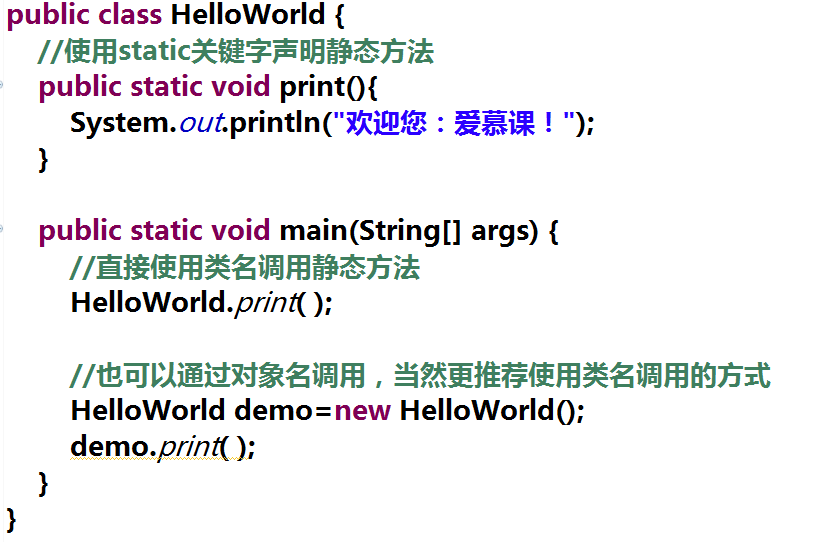摘要: 一個(gè)stmt多個(gè)rs進(jìn)行操作.那么從stmt得到的rs1,必須馬上操作此rs1后,才能去得到另外的rs2,再對(duì)rs2操作.不能互相交替使用,會(huì)引起rs已經(jīng)關(guān)閉錯(cuò)誤——Operation not allowed after ResultSet closed.錯(cuò)誤的代碼如下: stmt=conn.createStatement(); rs=stm...
閱讀全文
在 JDK1.5 引入自動(dòng)裝箱和拆箱的機(jī)制后,包裝類和基本類型之間的轉(zhuǎn)換就更加輕松便利了。
裝箱:把基本類型轉(zhuǎn)換成包裝類,使其具有對(duì)象的性質(zhì),又可分為手動(dòng)裝箱和自動(dòng)裝箱
int i= 10; //定義一個(gè)int基本類型值
Integer x = new Integer(i); //手動(dòng)裝箱
Integer y = i; //自動(dòng)裝箱
功能:將一個(gè)由英文字母組成的字符串轉(zhuǎn)換成指定格式---從右邊開始每三個(gè)字母用逗號(hào)分隔的形式。
請(qǐng)?jiān)诰庉嬈髦械牡?/span> 4、10 行將代碼填寫完整
運(yùn)行效果: j,aew,kjl,dfx,mop,zdmpublic static void main(String[] args) {
// Java文件名
String fileName = "HelloWorld.jav";
// 郵箱
String email = "laurenyang@imooc.com";
// 判斷.java文件名是否正確:合法的文件名應(yīng)該以.java結(jié)尾
/*
參考步驟:
1、獲取文件名中最后一次出現(xiàn)"."號(hào)的位置
2、根據(jù)"."號(hào)的位置,獲取文件的后綴
3、判斷"."號(hào)位置及文件后綴名
*/
//獲取文件名中最后一次出現(xiàn)"."號(hào)的位置
int index = fileName.lastIndexOf('.');
// 獲取文件的后綴
String prefix = fileName.substring(index);
// 判斷必須包含"."號(hào),且不能出現(xiàn)在首位,同時(shí)后綴名為"java"
if (index !=0 && index != -1 && prefix.equals("java")) {
System.out.println("Java文件名正確");
} else {
System.out.println("Java文件名無(wú)效");
}
// 判斷郵箱格式是否正確:合法的郵箱名中至少要包含"@", 并且"@"是在"."之前
/*
參考步驟:
1、獲取文件名中"@"符號(hào)的位置
2、獲取郵箱中"."號(hào)的位置
3、判斷必須包含"@"符號(hào),且"@"必須在"."之前
*/
// 獲取郵箱中"@"符號(hào)的位置
int index2 = email.indexOf("@");
// 獲取郵箱中"."號(hào)的位置
int index3 = email.indexOf('.');
// 判斷必須包含"@"符號(hào),且"@"必須在"."之前
if (index2 != -1 && index3 > index2) {
System.out.println("郵箱格式正確");
} else {
System.out.println("郵箱格式無(wú)效");
}
}
字節(jié)是計(jì)算機(jī)存儲(chǔ)信息的基本單位,1 個(gè)字節(jié)等于 8 位, gbk 編碼中 1 個(gè)漢字字符存儲(chǔ)需要 2 個(gè)字節(jié),1 個(gè)英文字符存儲(chǔ)需要 1 個(gè)字節(jié)。所以我們看到上面的程序運(yùn)行結(jié)果中,每個(gè)漢字對(duì)應(yīng)兩個(gè)字節(jié)值,如“學(xué)”對(duì)應(yīng) “-47 -89” ,而英文字母 “J” 對(duì)應(yīng) “74” 。同時(shí),我們還發(fā)現(xiàn)漢字對(duì)應(yīng)的字節(jié)值為負(fù)數(shù),原因在于每個(gè)字節(jié)是 8 位,最大值不能超過 127,而漢字轉(zhuǎn)換為字節(jié)后超過 127,如果超過就會(huì)溢出,以負(fù)數(shù)的形式顯示。
public static void main(String[] args) {
// 定義一個(gè)字符串
String s = "aljlkdsflkjsadjfklhasdkjlflkajdflwoiudsafhaasdasd";
// 出現(xiàn)次數(shù)
int num = 0;
// 循環(huán)遍歷每個(gè)字符,判斷是否是字符 a ,如果是,累加次數(shù)
for ( int i=0;i<s.length()-1;i++)
{
// 獲取每個(gè)字符,判斷是否是字符a
if ( 'a'==s.charAt(i) ) {
// 累加統(tǒng)計(jì)次數(shù)
num++;
}
}
System.out.println("字符a出現(xiàn)的次數(shù):" + num);
}
功能:將一個(gè)由英文字母組成的字符串轉(zhuǎn)換成指定格式---從右邊開始每三個(gè)字母用逗號(hào)分隔的形式。
請(qǐng)?jiān)诰庉嬈髦械牡?/span> 4、10 行將代碼填寫完整
運(yùn)行效果: j,aew,kjl,dfx,mop,zdm
public static void main(String[] args) {
// 創(chuàng)建一個(gè)空的StringBuilder對(duì)象
StringBuilder str = new StringBuilder();
// 追加字符串
str.append("jaewkjldfxmopzdm");
// 從后往前每隔三位插入逗號(hào)
for(int i = str.length()-3; i>0 ; i=i-3){
str.insert(i,",");
}
// 將StringBuilder對(duì)象轉(zhuǎn)換為String對(duì)象并輸出
System.out.print(str.toString());
}
結(jié)果: j,aew,kjl,dfx,mop,zdm
String s1 = "imooc";
String s2 = "imooc";
//定義字符串s3,保存“I love”和s1拼接后的內(nèi)容
String s3 = "I love" + s1;
// 比較字符串s1和s2
// imooc為常量字符串,多次出現(xiàn)時(shí)會(huì)被編譯器優(yōu)化,只創(chuàng)建一個(gè)對(duì)象
System.out.println("s1和s2內(nèi)存地址相同嗎?" + (s1 == s2));
//比較字符串s1和s3
System.out.println("s1和s3內(nèi)存地址相同嗎?" + (s1==s3));
String s4 = "I love " + s1;
//比較字符串s4和s3
// s1是變量,s4在運(yùn)行時(shí)才知道具體值,所以s3和s4是不同的對(duì)象
System.out.println("s3和s4內(nèi)存地址相同嗎?" + (s4 == s3));
//外部類HelloWorld
public class HelloWorld {
// 內(nèi)部類Inner,類Inner在類HelloWorld的內(nèi)部
public class Inner {
// 內(nèi)部類的方法
public void show() {
System.out.println("welcome to imooc!");
}
}
public static void main(String[] args) {
// 創(chuàng)建外部類對(duì)象
HelloWorld hello = new HelloWorld();
// 創(chuàng)建內(nèi)部類對(duì)象
Inner i = hello.new Inner();
// 調(diào)用內(nèi)部類對(duì)象的方法
i.show();
}
}





不清楚路徑的查找 : find / -name mysql
MYSQL常用經(jīng)典命令(沒有試過)
1.停止mysql
kill -9 `ps -ef | grep mysqld_safe| grep -v grep| awk '{print $2}'`
kill -9 `ps -ef | grep 'mysqld' | grep -v grep| awk '{print $2}'`
2.啟動(dòng)mysql
cd /usr/local/mysql-5.4.1-beta-linux-x86_64-glibc23
/bin/sh bin/mysqld_safe --user=mysql &
find /home/lijiajia/ -amin -10 #查找在系統(tǒng)中最后10分鐘訪問的文件
find /home/lijiajia/ -atime -2 #查找在系統(tǒng)中最后48小時(shí)訪問的文件
find /home/lijiajia/ -empty #查找在系統(tǒng)中為空的文件或者文件夾
find /home/lijiajia/ -mmin -5 # 查找在系統(tǒng)中最后5 分鐘里修改過的文件
find /home/lijiajia/ -mtime -1 #查找在系統(tǒng)中最后24 小時(shí)里修改過的文件
find /home/lijiajia/ -nouser #查找在系統(tǒng)中屬于作廢用戶的文件(不明白是什么意思)
find /home/lijiajia/ -amin 10 #查找在系統(tǒng)中最后10分鐘訪問的文件
find /home/ftp/pub -user lijiajia #查找在系統(tǒng)中屬于lijiajia這個(gè)用戶的文件
public static Map ConvertObjToMap(Object obj){
Map<String,Object> reMap = new HashMap<String,Object>();
if (obj == null)
return null;
Field[] fields = obj.getClass().getDeclaredFields();
try {
for(int i=0;i<fields.length;i++){
try {
Field f = obj.getClass().getDeclaredField(fields[i].getName());
f.setAccessible(true);
Object o = f.get(obj);
if(o == null){
o = "";
}else{
o = String.valueOf(o);
}
reMap.put(fields[i].getName(), String.valueOf(o));
} catch (NoSuchFieldException e) {
// TODO Auto-generated catch block
e.printStackTrace();
} catch (IllegalArgumentException e) {
// TODO Auto-generated catch block
e.printStackTrace();
} catch (IllegalAccessException e) {
// TODO Auto-generated catch block
e.printStackTrace();
}
}
} catch (SecurityException e) {
// TODO Auto-generated catch block
e.printStackTrace();
}
return reMap;
}
import java.io.IOException;
import java.util.Date;
import org.apache.commons.httpclient.HttpClient;
import org.apache.commons.httpclient.HttpException;
import org.apache.commons.httpclient.NameValuePair;
import org.apache.commons.httpclient.methods.PostMethod;
import org.dom4j.Document;
import org.dom4j.DocumentException;
import org.dom4j.DocumentHelper;
import org.dom4j.Element;
import com.alibaba.fastjson.JSONObject;
import com.huoniu.openapi.constant.Constant.MESSAGE;
import com.huoniu.openapi.constant.InvokeContext;
import com.huoniu.openapi.model.RetCode;
import com.huoniu.openapi.model.RetMsg;
import com.huoniu.openapi.model.SmsCode;
import com.huoniu.openapi.service.SmsCodeService;
import com.huoniu.openapi.utils.AESUtil;
import com.huoniu.openapi.utils.SmsUtil;
import com.huoniu.openapi.web.interceptor.InvokeContextInitInterceptor;
import com.puff.framework.annotation.Before;
import com.puff.framework.annotation.Controller;
import com.puff.framework.annotation.Inject;
import com.puff.framework.annotation.InterceptorChain;
import com.puff.framework.utils.JsonUtil;
import com.puff.framework.utils.StringUtil;
import com.puff.web.view.TextView;
import com.puff.web.view.View;
import com.puff.web.view.ViewFactory;
@Controller("/rest/sms")
public class HuyiSmsController {
private static String content = "您的驗(yàn)證碼是:%s。請(qǐng)不要把驗(yàn)證碼泄露給其他人。";
public View send(){
String invokeData = InvokeContext.getInvokeData();
if (StringUtil.blank(invokeData)) {
return json(RetMsg.error(RetCode.OTHER_ERROR, "發(fā)送短信失敗!"));
}
JSONObject jsonObject = JSONObject.parseObject(invokeData);
String mobile = jsonObject.getString("customer_no");
if (StringUtil.blank(mobile)) {
return json(RetMsg.error(RetCode.NULL_PARAM, "手機(jī)號(hào)碼不能為空"));
}
HttpClient client = new HttpClient();
PostMethod method = new PostMethod(MESSAGE.NEW_MESSAGEURL); //接口地址
client.getParams().setContentCharset("UTF-8");
method.setRequestHeader("ContentType","application/x-www-form-urlencoded;charset=UTF-8");
int mobile_code = (int)((Math.random()*9+1)*100000);
System.out.println("mobile_code : "+mobile_code);
NameValuePair[] data = {//提交短信
new NameValuePair("account", MESSAGE.NEW_ACCOUNT),
new NameValuePair("password", SmsUtil.MD5Encode(MESSAGE.NEW_PASSWORD)),
new NameValuePair("mobile", mobile),
new NameValuePair("content", String.format(content, mobile_code)),
};
method.setRequestBody(data);
try {
client.executeMethod(method);
String SubmitResult =method.getResponseBodyAsString();
Document doc = DocumentHelper.parseText(SubmitResult);
Element root = doc.getRootElement();
String code = root.elementText("code");
String msg = root.elementText("msg");
String smsid = root.elementText("smsid");
if(code == "2"){ //發(fā)送成功,寫庫(kù)
}
} catch (HttpException e) {
e.printStackTrace();
} catch (IOException e) {
e.printStackTrace();
} catch (DocumentException e) {
e.printStackTrace();
}
return json(RetMsg.success("發(fā)送成功!!!"));
}
public View json(RetMsg msg) {
String data = JsonUtil.toJson(msg);
if (InvokeContext.isEncrypt()) {
data = AESUtil.encrypt(data);
}
return ViewFactory.text(data, TextView.ContentType.JSON);
}
}
import org.apache.commons.httpclient.HttpClient;
import org.apache.commons.httpclient.NameValuePair;
import org.apache.commons.httpclient.methods.PostMethod;
import com.alibaba.fastjson.JSONObject;
import com.huoniu.openapi.constant.Constant.TONGLIAN;
public class TLInterfaceService {
private static final String USERNAME = "";
private static final String PASSWORD = "";
private static final String TENANT = "";
private static final String GRANT_TYPE_GET = "password";
private static final String GRANT_TYPE_REFRESH = "refresh_token";
private static String TOKEN = null;
private static String REFRESH_TOKEN = null;
private static long EXPIRES_IN ;
private static long START_DATE;
public String getToken() {
if(TOKEN==null){
TOKEN = login();
}else{
Date date = new Date();
if(START_DATE-date.getTime()<EXPIRES_IN-30){
TOKEN = refresh();
}
}
return TOKEN;
}
public void setToken(String token) {
TOKEN = token;
}
/**
* 登陸,獲取token
* @return
*/
public static String login(){
HttpClient httpClient = new HttpClient();
String URL = String.format(TONGLIAN.PREV_PATH, ""); //接口地址
try {
PostMethod postMethod = new PostMethod(URL);
postMethod.addRequestHeader("Content-Type","application/x-www-form-urlencoded");
NameValuePair[] data = {
new NameValuePair("username", USERNAME),
new NameValuePair("password", PASSWORD),
new NameValuePair("tenant", TENANT),
new NameValuePair("grant_type", GRANT_TYPE_GET)
};
postMethod.setRequestBody(data);
int statusCode = httpClient.executeMethod(postMethod);
if(200 == statusCode){
String body = postMethod.getResponseBodyAsString();
JSONObject json=JSONObject.parseObject(body);
TOKEN = json.getString("access_token");
REFRESH_TOKEN = json.getString("refresh_token");
EXPIRES_IN = Long.parseLong(json.getString("expires_in"));
START_DATE = (new Date()).getTime();
}
} catch (Exception e) {
}
return TOKEN;
}
/**
* refresh_token
* @return
*/
public static String refresh(){
HttpClient httpClient = new HttpClient();
String URL = String.format(TONGLIAN.PREV_PATH, ""); //接口地址
try {
PostMethod postMethod = new PostMethod(URL);
postMethod.addRequestHeader("Content-Type","application/x-www-form-urlencoded");
NameValuePair[] data = {
new NameValuePair("refresh_token", REFRESH_TOKEN),
new NameValuePair("grant_type", GRANT_TYPE_REFRESH)
};
postMethod.setRequestBody(data);
int statusCode = httpClient.executeMethod(postMethod);
if(200 == statusCode){
String body = postMethod.getResponseBodyAsString();
JSONObject json=JSONObject.parseObject(body);
TOKEN = json.getString("access_token");
REFRESH_TOKEN = json.getString("refresh_token");
EXPIRES_IN = Long.parseLong(json.getString("expires_in"));
START_DATE = (new Date()).getTime();
}
} catch (Exception e) {
}
return TOKEN;
}
}